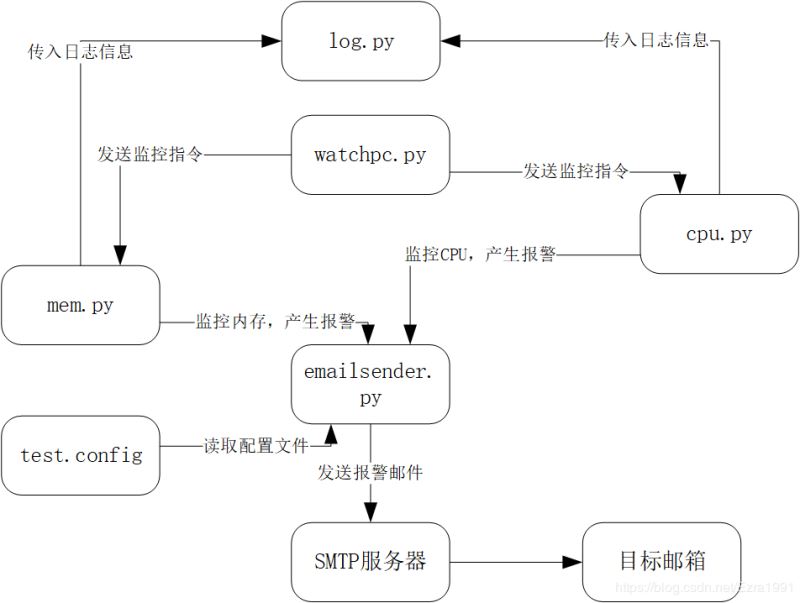Python实现报警信息实时发送至邮箱功能,具体内容如下所示:
程序设计

实现代码
cpu.py
# -*- coding: utf-8 -*-
import psutil
import time
from emailsender import txtMail
from log import myloggers
import gc
class mycpumonitor():
# up是cpu监控的阈值,默认是90%
def __init__(self, up=None):
self.up = 90 if up is None else up
def cpu_monitor(self):
cpu_percent = psutil.cpu_percent()
now = time.strftime("%Y-%m-%d %H:%M:%S", time.localtime())
if cpu_percent > self.up:
filename = 'cpu.txt'
with open(filename, 'w') as f: # 如果filename不存在会自动创建, 'w'表示写数据,写之前会清空文件中的原有数据!
f.write(str(now) + "CPU使用率超过" + str(self.up) + "!!!!.\n")
f.write(str(now) + "当前CPU使用率" + str(cpu_percent) + "!!!\n")
mail = txtMail()
try:
mail.txt_send_mail(filename="test.config", alarm=filename)
temp_msg = "CPU超标,当前CPU使用率:" + str(cpu_percent)
logger1 = myloggers(temp_msg)
logger1.maillogging()
del mail
gc.collect()
except:
print("文本文件格式不正确")
mem.py
# -*- coding: utf-8 -*-
import psutil
import time
from emailsender import txtMail
from log import myloggers
import gc
class mymemmonitor():
# up是内存监控的阈值,默认是90%
def __init__(self, up=None):
self.up = 90 if up is None else up
def mem_monitor(self):
mem_percent = psutil.virtual_memory()[2]
now = time.strftime("%Y-%m-%d %H:%M:%S", time.localtime())
if mem_percent > self.up:
filename = 'mem.txt'
with open(filename, 'w') as f: # 如果filename不存在会自动创建, 'w'表示写数据,写之前会清空文件中的原有数据!
f.write(str(now) + "内存使用率超过" + str(self.up) + "!!!!.\n")
f.write(str(now) + "当前内存使用率" + str(mem_percent) + "!!!\n")
mail = txtMail()
try:
mail.txt_send_mail(filename="test.config", alarm=filename)
temp_msg = "内存超标,当前内存使用率:" + str(mem_percent)
logger1 = myloggers(temp_msg)
logger1.maillogging()
del mail
gc.collect()
except:
print("文本文件格式不正确")
watchpc.py
# -*- coding: utf-8 -*- # Author: WuYang # Date-modified: 07Nov2019 # Function: send alarm data through SMTP protocol # Architecture: cpu.py, mem.py, etc. is to monitor performance of server # Lang: Python3.7 # Env: CentOS7/WindowServer 2012R2 import time from cpu import mycpumonitor from mem import mymemmonitor import gc if __name__ == "__main__": while True: memObj = mymemmonitor(50) memObj.mem_monitor() cpuObj = mycpumonitor(10) cpuObj.cpu_monitor() del memObj gc.collect() time.sleep(10)
emailsender.py
#-*- coding: utf-8 -*-
import smtplib
import chardet
import codecs
import os
from email.mime.text import MIMEText
from email.header import Header
from email.mime.multipart import MIMEMultipart
# 第三方SMTP服务
class txtMail(object):
def __init__(self, host=None, auth_user=None, auth_password=None):
self.host = "smtp.163.com" if host is None else host # 设置发送邮件服务使用专用报警账户的用户名
self.auth_user = "xxxxxx@163.com" if auth_user is None else auth_user # 上线时使用专用报警账户的用户名
self.auth_password = (
"xxxxxxxx" if auth_password is None else auth_password
) # 上线时使用专用报警账户的密码
self.sender = "xxxxxxxx@163.com"
def send_mail(self, subject, msg_str, recipient_list, attachment_list=None):
message = MIMEMultipart()
message["From"] = self.sender
message["To"] = Header(";".join(recipient_list), "utf-8")
message["Subject"] = Header(subject, "utf-8")
message.attach(MIMEText(msg_str, "plain", "utf-8"))
# 如果有附件,则添加附件
if attachment_list:
for att in attachment_list:
attachment = MIMEText(open(att, "rb").read(), "base64", "utf-8")
attachment["Content-Type"] = "application/octet-stream"
# 这里filename可以任意写,写什么名字,邮件中显示什么名字
filename = os.path.basename(att)
attachment.add_header(
"Content-Disposition",
"attachment",
filename=("utf-8", "", filename),
)
message.attach(attachment)
smtpObj = smtplib.SMTP_SSL(self.host)
smtpObj.connect(self.host, smtplib.SMTP_SSL_PORT)
smtpObj.login(self.auth_user, self.auth_password)
smtpObj.sendmail(self.sender, recipient_list, message.as_string())
smtpObj.quit()
print("邮件发送成功")
print(attachment_list)
def guess_chardet(self, filename):
"""
:param filename: 传入一个文本文件
:return: 返回文本文件的编码格式
"""
encoding = None
try:
# 由于本需求所解析的文本文件都不大,可以一次性读入内存
# 如果是大文件,则读取固定字节数
raw = open(filename, "rb").read()
if raw.startswith(codecs.BOM_UTF8): # 处理UTF-8 with BOM
encoding = "utf-8-sig"
else:
result = chardet.detect(raw)
encoding = result["encoding"]
except:
pass
return encoding
def txt_send_mail(self, filename, alarm):
"""
:param filename:
:return:
将指定格式的txt文件发送至邮箱,txt文件样例如下
# 收件人,逗号分隔
# 附件,逗号分隔
"""
with open(filename, encoding=self.guess_chardet(filename)) as f:
lines = f.readlines()
recipient_list = lines[0].strip().split(",")
attachment_list = []
for file in lines[-1].strip().split(","):
if os.path.isfile(file):
attachment_list.append(file)
# 如果没有附件,则为None
if attachment_list == []:
attachment_list = None
with open(alarm, encoding=self.guess_chardet(alarm)) as f1:
lines1 = f1.readlines()
subject = lines1[0].strip()
msg_str = "".join(lines1[1:])
self.send_mail(
subject=subject,
msg_str=msg_str,
recipient_list=recipient_list,
attachment_list=attachment_list,
)
test.config
XXXXX@qq.com,XXXXX@163.com libvirt.log,qemu.log
注意事项
需进入邮箱设置,开启POP3/SMTP/IMAP。

总结
以上所述是小编给大家介绍的Python实现报警信息实时发送至邮箱功能,希望对大家有所帮助,如果大家有任何疑问请给我留言,小编会及时回复大家的。在此也非常感谢大家对网站的支持!
如果你觉得本文对你有帮助,欢迎转载,烦请注明出处,谢谢!